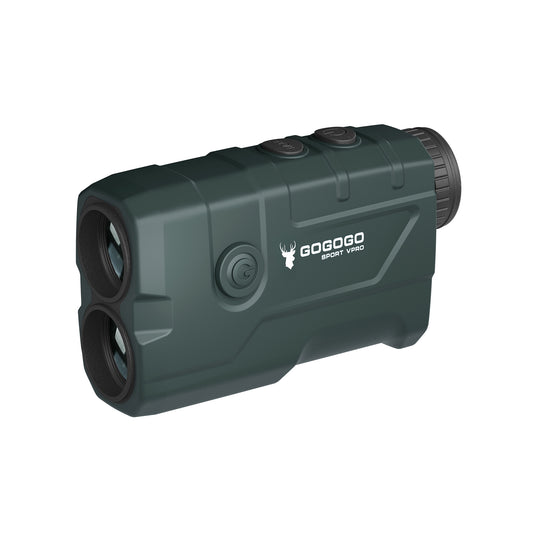A golf rangefinder is a valuable tool for any golfer, but a rangefinder with a slope function is even more beneficial. This feature calculates the adjusted distance to the green, taking into account uphill and downhill slopes. By providing accurate distance measurements, a slope rangefinder can significantly improve your golf game.

How Does the Slope Function Work?
The slope function in a golf rangefinder measures the angle of elevation or decline between you and your target and adjusts the distance accordingly. Golf courses are rarely flat, and elevation changes can have a significant impact on how far your ball will travel. For instance, if you're hitting a shot uphill, the adjusted distance will be longer than the horizontal distance. Conversely, if you're hitting a shot downhill, the adjusted distance will be shorter. By accounting for these slope variations, a slope rangefinder helps you select the correct club and make more accurate shots.
A golf rangefinder with slope calculates the true distance to the target by factoring in the slope angle. It provides both the actual distance and the "play-as" distance, helping you select the appropriate club and make more informed decisions. Some advanced models even allow you to toggle the slope feature on or off, ensuring compliance with tournament rules where slope-enabled devices are not permitted.
Benefits of Using a Golf Rangefinder with Slope
- Improved Accuracy: The primary advantage of using a golf rangefinder with slope is the improved accuracy it provides. By accounting for elevation changes, these devices eliminate guesswork and ensure you have the most precise information possible. This can lead to better shot execution and lower scores.
- Enhanced Confidence: Having reliable data at your fingertips boosts your confidence. You’ll no longer second-guess your club choice or swing strength, as the rangefinder gives you a clear understanding of how to approach each shot.
- Time Savings:Traditional methods of gauging distances, such as yardage markers or GPS apps, can be time-consuming and less accurate. A golf rangefinder with slope provides instant feedback, allowing you to focus more on your game and less on calculations.
- Versatility: Many slope-enabled rangefinders allow users to switch off the slope function, making them legal for tournament play. This versatility ensures you can use the same device for both casual rounds and competitive play.
- Skill Development: Using a rangefinder with slope helps you develop a deeper understanding of course management. Over time, you’ll become better at judging how elevation changes impact your shots, even when playing without the device.
Best Golf Rangefinders with Slope Recommend
Now that you understand the benefits of a slope rangefinder, let's explore some of the top-rated models on the market:
1. Gogogo GS24 Golf Rangefinder
The Gogogo GS24 is a budget-friendly option that offers impressive performance. It features a clear OLED display, 6x magnification, and a slope function that provides accurate distance measurements. The GS24 is also lightweight and easy to use, making it a great choice for golfers of all skill levels.
Key Features:
- OLED display
- 6x magnification
- 600-1200 yards range optional
- Slope function
- Compact design

2. Bushnell Tour V5 Shift Slope Rangefinder
Bushnell is a well-known brand that produces high-quality golf rangefinders. Their models offer advanced features like slope technology, vibration feedback, and precise distance measurements. Bushnell rangefinders are known for their durability and reliability, making them a popular choice among serious golfers.
Key Features:
- OLED display
- 6x magnification
- 1,000-yard range
- Slope function
- Compact design

3. TecTecTec VPRO500 Rangefinder
TecTecTec is another reputable brand that offers affordable and effective golf rangefinders. Their models feature slope technology, clear displays, and long battery life. TecTecTec rangefinders are a great option for golfers who want a reliable and accurate rangefinder without breaking the bank.
Key Features:
- LCD display
- 6x magnification
- 540-yard range
- Slope function
- Compact design

Choosing the Right Golf Rangefinder with Slope
When selecting a golf rangefinder with slope, consider the following factors:
- Accuracy:Look for devices with high accuracy and fast measurement speeds.
- Ease of Use: A simple interface and clear display are crucial for quick and efficient readings.
- Range: Ensure the rangefinder covers the distances you typically encounter on the course.
- Durability: Opt for models with robust construction and weather resistance.
- Battery Life: Long-lasting batteries ensure your device won’t let you down mid-round.
- Price: Choose a rangefinder that fits your budget while meeting your performance needs.

FAQs
Is a slope rangefinder legal in tournament play?
No, slope rangefinders are not allowed in tournament play under the rules of golf. The slope functionality provides an unfair advantage by calculating elevation-adjusted distances, which is prohibited during competitive rounds. However, most modern slope rangefinders offer the ability to disable the slope feature. With the slope function turned off, these devices become tournament-legal and can still provide valuable assistance.
How do I turn the slope function on or off?
The process for toggling the slope function varies depending on the rangefinder model. Most devices have a dedicated button, mode switch, or settings menu to enable or disable the slope feature. For detailed instructions, consult your rangefinder’s user manual. Many manufacturers also provide online tutorials or customer support to help you navigate these settings.
Can I use a slope rangefinder for other sports?
Yes, while golf rangefinders are specifically designed for golf, they can also be used for other activities such as archery, hunting, and birdwatching. The precise distance measurements provided by the rangefinder make it versatile across various sports and hobbies. However, the slope function may not be as beneficial in these contexts unless elevation adjustments are a critical factor in your activity.







![[2025] The Ultimate Guide to Pinseeker Rangefinders for Golfers](http://gogogosport.com/cdn/shop/articles/gogogo_sport_vpro_pinseeker_rangefinder.png?v=1757993796&width=533)